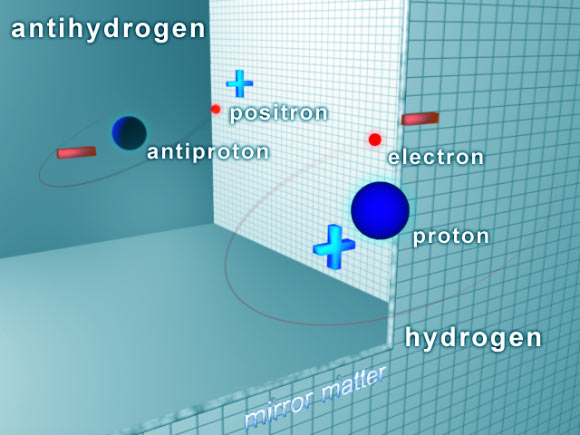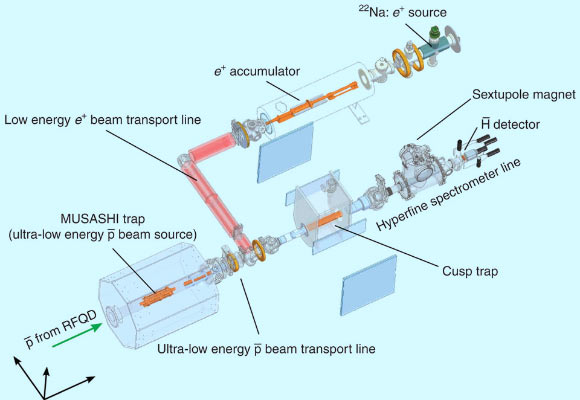Physicists from CERN’s Atomic Spectroscopy and Collisions Using Slow Antiprotons (ASACUSA) project say they have produced at least 80 atoms of antihydrogen.

Hydrogen’s electron and proton have oppositely charged antimatter counterparts in the antihydrogen: the positron and antiproton. Image credit: NSF.
Current theories predict that the Universe could just as easily be made of antimatter as of matter and don’t explain why our Universe is made up exclusively of the latter. If scientists find small differences in the properties of matter and antimatter, they would contradict the present paradigm and might help solve the riddle.
Nevertheless, it is possible to produce significant amounts of antihydrogen (a positron bound to an antiproton) in experiments by mixing positrons and low energy antiprotons.
The spectra of hydrogen and antihydrogen are predicted to be identical, so any tiny difference between them would immediately open a window to new physics, and could help in solving the antimatter mystery.
With its single proton accompanied by just one electron, hydrogen is the simplest existing atom, and one of the most precisely investigated and best understood systems in modern physics. Thus comparisons of hydrogen and antihydrogen atoms constitute one of the best ways to perform highly precise tests of matter/antimatter symmetry.
Matter and antimatter annihilate immediately when they meet, so aside from creating antihydrogen, one of the key challenges for physicists is to keep antiatoms away from ordinary matter.

Schematic view of ASACUSA’s experimental apparatus. Antiprotons delivered from the antiproton decelerator via the radio-frequency quadrupole decelerator (RFQD) are trapped, electron-cooled and radially compressed in an ultra-slow antiproton beam source, named MUSASHI. Moderated positrons from a 22Na source are prepared and cooled in the positron accumulator and then are transported to the cusp trap. The cusp trap consists of multiple ring electrodes and superconducting anti-Helmholtz coils. After positrons are accumulated near the maximum magnetic field region, antiprotons are injected from the MUSASHI and mixed with positrons synthesizing antihydrogen atoms. Antihydrogen atoms in low-field-seeking states are focused downstream of the cusp trap due to the strong magnetic field gradient, while those high-field-seeking states are de-focused. Thus, a polarized antihydrogen beam is produced. Image credit: Kuroda N et al.
To do so, experiments take advantage of antihydrogen’s magnetic properties and use very strong non-uniform magnetic fields to trap antiatoms long enough to study them.
However, the strong magnetic field gradients degrade the spectroscopic properties of the antiatoms.
To allow for clean high-resolution spectroscopy, the physicists developed an innovative set-up to transfer antihydrogen atoms to a region where they can be studied in flight, far from the strong magnetic field.
“Antihydrogen atoms having no charge, it was a big challenge to transport them from their trap. Our results are very promising for high-precision studies of antihydrogen atoms, particularly the hyperfine structure, one of the two best known spectroscopic properties of hydrogen. Its measurement in antihydrogen will allow the most sensitive test of matter/antimatter symmetry,” said Dr Yasunori Yamazaki of RIKEN in Japan, the senior author of a paper published in the journal Nature Communications.
“We are looking forward to restarting this summer with an even more improved set-up.”
______
Kuroda N et al. 2014. A source of antihydrogen for in-flight hyperfine spectroscopy. Nature Communications 5, article number: 3089; doi: 10.1038/ncomms4089







